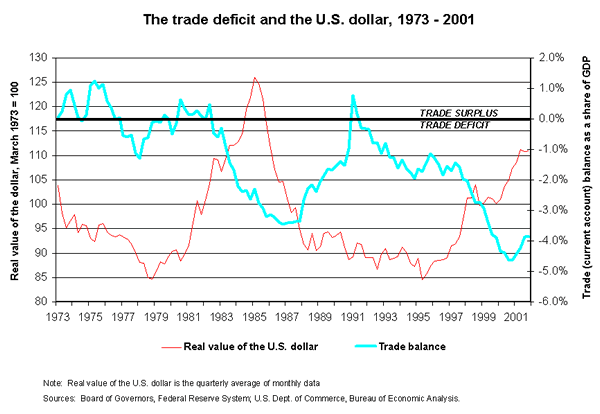A weekly presentation of downloadable charts and short analyses designed to graphically illustrate important economic issues. Updated every Wednesday.
Snapshot for April 10, 2002.
Surging dollar contributes to growing trade deficit, job loss
Steady growth in the value of the U.S. dollar over the last seven years has played a major role in the growth of the U.S. trade deficit and the catastrophic recession in U.S. manufacturing industries. Between the second quarter of 1995 and the last quarter of 2001, the real, inflation adjusted value of the U.S. dollar increased by 31.3% (see figure below). In the same period, the U.S. trade deficit1 has mushroomed from -1.7% of U.S. gross domestic product (output) to -3.9%, an increase of 121.5%. Since April 1998, when employment peaked, U.S. manufacturing has lost 2.1 million jobs.

When the dollar increases in value, U.S. exports become more expensive in other markets, and therefore less competitive. A rise in the value of the dollar makes imports cheaper in this country, causing them to increase. The trade balance is defined as the difference between exports and imports. When exports decline and imports expand, the trade deficit increases (these relationships are illustrated in the figure). Between late 1978 and late 1985, the real value of the dollar increased 48.9%, and the trade deficit surged from -0.1% to -3.2% of GDP. The process also works in reverse, to some extent, when the dollar falls. When the dollar fell 30% between 1985 and 1991, the trade balance briefly moved into a surplus (which also coincided with a mild recession and the gulf war, which resulted in a temporary flow of military payments to the U.S. from the Gulf States).
Most U.S. imports and exports are produced in manufacturing industries. When imports rise or exports fall, output either declines or fails to grow in U.S. factories. In either case, a loss of manufacturing jobs usually results when trade deficits grow. A number of other factors besides exchange rate problems have helped cause the steady growth of U.S. trade deficits since the late 1970s. These include high barriers to U.S. exports, dumping and foreign industrial targeting of U.S. import markets, and the roles played by multinational companies in moving production offshore.
Enormous capital inflows (foreign investment in the United States) were largely responsible for pushing up the value of the dollar and causing sharply rising current account deficits between 1995 and 2002. Annual net capital inflows soared from $100 to $150 billion per year in 1993-96 to more than $400 billion in 2001. Financial and economic instability abroad following the Asian crisis in 1997 motivated much of the flight of foreign investors to the U.S. economy in the 1997-99 period. The U.S. Treasury has maintained a “hands off” policy towards the dollar, and has repeatedly issued statements in support of a “strong dollar.” These policies of dollar neglect have doomed thousands of U.S. manufacturing firms and millions of manufacturing jobs in the past few years alone.
Endnotes:
1. The U.S. current account balance, which is the broadest measures of overall U.S. international payments, including trade in goods, services and other income flows, is shown in the figure below as a share of U.S. Gross Domestic Product (GDP).
This week’s Snapshot by EPI economist Robert E. Scott.
Check out the archive for past Economic Snapshots.
